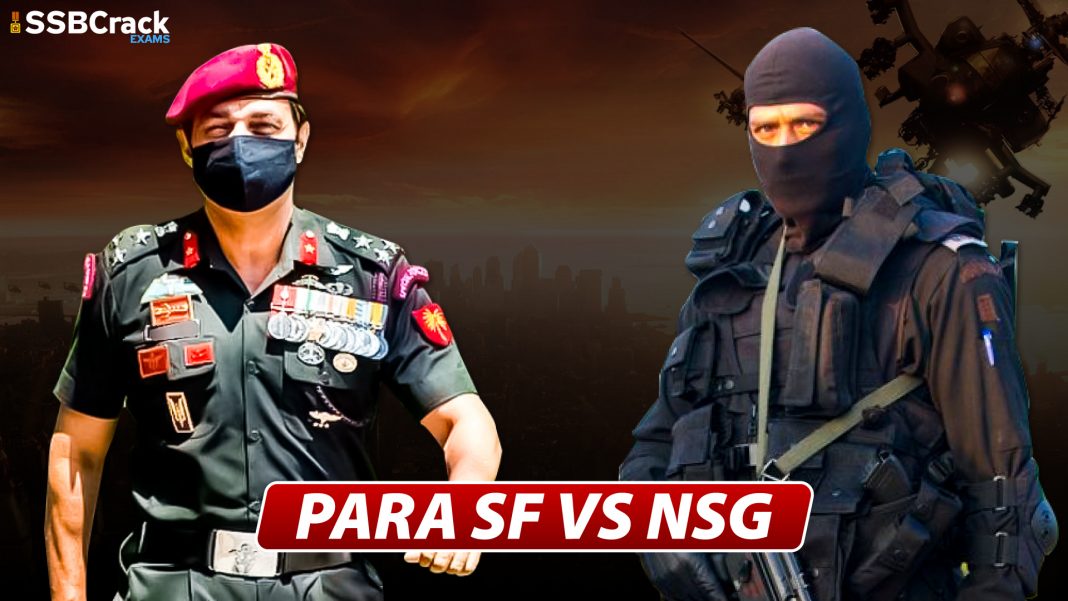We know that both these forces have proven their combat capabilities time and again. In the case of most aspirants, the slight chance of ending up in one of these elite units is a major reason why they chose this path. Both these forces operate in a very secretive manner, hence speculations are often all we get about them. For aspirants, we present the difference between PARA-SF and NSG.
PARA-SF
The Indian Army’s Para (Special Forces), often known as Para SF, is a special forces unit that is part of the Parachute Regiment. Hostage rescue, counter-terrorism, unconventional warfare, special reconnaissance, foreign internal defense, counter-proliferation, counter-insurgency, search and destroy, and human recovery are among the unit’s specialties.
The 50th Parachute Brigade was formed in October 1941 during World War II, and the unit’s history dates back to that time. The 9th Parachute Special Forces Battalion, part of the Parachute Regiment, was created in 1966 as the 9th Parachute Commando Battalion. It is the oldest of the Indian Army’s nine para SF battalions. It has participated in several successful operations throughout its history, including the 1971 Indo-Pakistan conflict, Operation Bluestar, Operation Pawan, Operation Cactus, the Kargil War, the 2015 Indian counter-insurgency operation in Myanmar, the 2016 Indian Line of Control strike, and countless anti-terror operations.
Structure and Organisation
Nine Special Forces, five Airborne, two Territorial Army, and one Counter-Insurgency (Rashtriya Rifles) battalions make up the Parachute Regiment. The regiment attempted to raise additional battalions to supplement the special forces’ strength, but the mission was not accomplished owing to the difficult selection process. Furthermore, in the absence of a centralized command and a unified and regulated method for selection, selection procedures vary even across Para (SF) battalions. To put it another way, various Para (SF) battalions have varying entry requirements.
There were intentions in the mid-1980s to combine the three para commando battalions of the Parachute Regiment into a single specialized organization, the Special Forces Regiment. However, because of logistical and administrative challenges, these plans were shelved, and the Parachute Regiment continues to train and recruit them.
The 9 battalions are:
- 1 PARA (SF) – for urban warfare and CI/CT
- 2 PARA (SF) – for mountain warfare and CI/CT
- 3 PARA (SF) – for desert warfare and CI/CT
- 4 PARA (SF) – for mountain warfare and CI/CT
- 9 PARA (SF) – for mountain warfare, urban warfare and CI/CT
- 10 PARA (SF) – for desert warfare and CI/CT
- 11 PARA (SF) – for jungle warfare and CI/CT
- 12 PARA (SF) – for jungle & mountain warfare and CI/CT
- 21 PARA (SF) – for jungle & mountain warfare and CI/CT
Functions
- Special reconnaissance, gathering intelligence
- Deep penetration and precision strikes behind enemy lines to sabotage crucial enemy facilities and communications.
- The Indian Army’s counter-terrorist and counter-insurgency operations include both covert and overt/direct action special operations.
- Hostage rescue operations are carried out both within and outside of Indian territory.
- Special operations, direct action, hostage rescue, counter-terrorism, special reconnaissance, foreign internal defense, counter-proliferation, counter-insurgency, search and destroy, and people recovery are among the duties assigned to the force.

Selection & Training
Volunteers make up the whole Indian paratrooper force. Some new recruits join the Para regiments, while others move from regular army formations. They go through a three-month probationary period / selection process for Paratroopers (Airborne) Battalions (5,6,7,23,29) and six-month probationary period / selection process for Para (Special Forces) Battalions (1,2,3,4,9,10,11,12,21 PARA). To be a para (Special Forces), all personnel must first qualify as Paratroopers; once selected, candidates may choose to advance to the SF
The first training to become a special forces operator takes 3.5 years, which is the longest in the world, but the training is ongoing. Members of the special forces get both basic and advanced training. They learn specialized infiltration and exfiltration techniques, either by air (fight freefall) or by water (combat diving).
NSG
The National Security Guard (NSG) is the Ministry of Home Affairs’ special counter-terrorism organization (MHA). Following Operation Blue Star, the Golden Temple attack, and the death of Indian Prime Minister Indira Gandhi, it was established on October 16, 1984, under the National Security Guard Act of 1986, “to fight terrorist operations and defend states against internal disturbances.” The Black Cats are a nickname for members of the National Security Guard.
Structure and Organisation
Special Action Unit (SAG)
SAGs 51 and 52 are the two types of Special Action Groups. The counter terrorist force (CTF), which is NSG’s counter-terrorist arm, is made up of both of them, as well as 11 SRG. Counter-terrorist and counter-insurgency operations are handled by 51 SAG and 11 SRG, while anti-hijacking operations are handled by 52 SAG. SRG members are mostly selected from CAPFs, whilst SAG members are mostly drawn from the Indian Army.
Special Ranger Group (SRG)
Special Ranger Groups (SRG) 11, 12, and 13 are the three SRGs. Along with 51 SAG, 11 SRG is part of the counter-terrorist force (CTF) and is solely employed for counter-terrorist activities. Close protection and special security services are provided by the 12 and 13 SRG for India’s high-profile targets, such as the defence minister. Border guarding troops like the BSF, ITBP, and SSB, as well as Internal Security Forces like the CRPF, CISF, and Assam Rifles, make up the SRG. In recent years, the Government of India has opted to withdraw SRGs from protection responsibilities and refocus them only on NSG mandates such as SAG and 11 SRG.
Special Composite Group (SCG)
The Special Composite Group (SCG) of the National Security Group (NSG) has established five regional centers for regional deployment. SCG is made of of Army and CAPF troops who are responsible for counter-terrorist activities in their area of duty. As Group Commander, each SCG is led by a colonel-rank officer on deputation from the Indian Army. The five regional hubs are as follows:
- 26 SCG Mumbai
- 27 SCG Chennai
- 28 SCG Hyderabad
- 29 SCG Kolkata
- 30 SCG Gandhinagar
Functions
- Counter hijacking tasks on land, sea, and air
- Bomb disposal (search, detection and neutralization of IEDs)
- Post Blast Investigation (PBI)
- Hostage Rescue missions like in Taj Hotel during 26/11 Mumbai attack
- VIP security (like security to Cabinet Ministers and others eminent persons)
Selection & Training
Selection is difficult, with a dropout rate of 70–80 percent. The basics take up three months of their 14-month training in Manesar, Haryana. A cross-country obstacle course, jumping from heights and over divides, and ascending various types of terrain are among the 26 aspects of physical fitness training. At the end of an obstacle-filled cross-country marathon, one endurance test combines martial arts and target shooting. This is used to assess the candidate’s ability to perform under duress and tiredness. Those who pass the examinations will be assigned to advanced training for nine months.Aspirants must also pass a psychological examination before being accepted into the NSG. Urban counter-terrorism, underwater operations, home intervention, counter-UAV and anti-drone operations, bomb detection and disposal abilities, and several other specialisations are all included in the training.
Conclusion
Regardless of the challenges they face, both these forces are well trained and well equipped to overcome them. Although they are trained to serve different functions, one common factor between them would be their rigorous training and commitment to excellence. Aspirants should be inspired by this and aim to inculcate that relentless pursuit for the objectives set for themselves. SSBCrack provides ample resources to support aspirants in their journey.
Also Read:







Jai jawan jai kishan
Jai Hind Jai Bharat